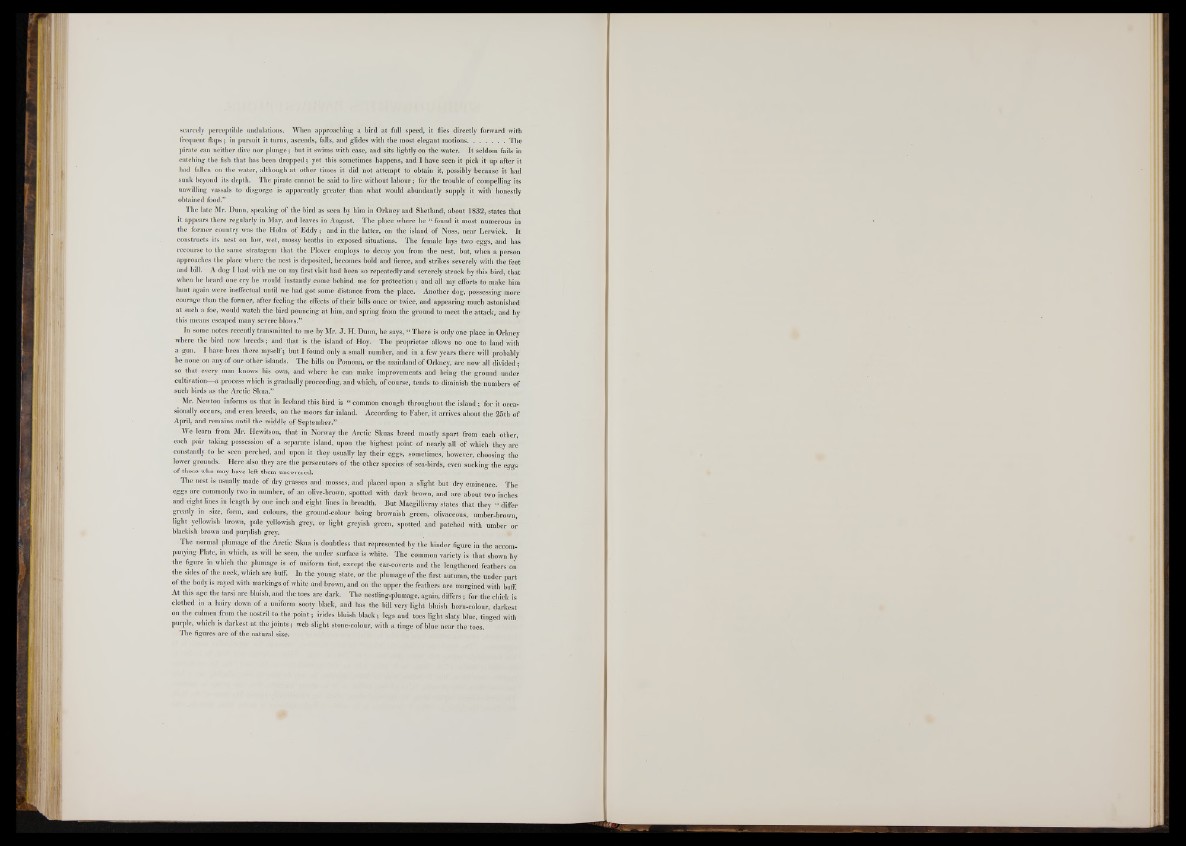
scarcely perceptible undulations. When approaching a bird at full speed, it flies directly forward with
frequent flaps; in pursuit it turns, ascends, falls, and glides with the most elegant motions......................The
pirate can neither dive nor plunge; but it swims with ease, and sits lightly on the water. It seldom fails in
catching the fish that has been dropped; yet this sometimes happens, and I have seen it pick it up after it
had fallen on the water, although at other times it did not attempt to obtain it, possibly because it had
sunk beyond its depth. The pirate cannot be said to live without labour; for the trouble o f compelling its
unwilling vassals to disgorge is apparently greater than what would abundantly supply it with honestly
obtained food.”
The late Mr. Dunn, speaking of the bird as seen by him in Orkney and Shetland, about 1832, states that
it appears there regularly in May, and leaves in August. The place where he “ found it most numerous in
the former country was the Holm of Eddy; and in the latter, on the island o f Noss, near Lerwick. It
constructs its nest on low, wet, mossy heaths in exposed situations. The female lays two eggs, and has
recourse to the same stratagem that the Plover employs to decoy you from the nest, but, when a person
approaches the place where the nest is deposited, becomes bold and fierce, and strikes severely with the feet
and bill. A dog I had with me on my first visit had been so repeatedly and severely struck by this bird, that
when he heard one cry he would instantly come behind me for protection; and all my efforts to make him
hunt again were ineffectual until we had got some distance from the place. Another dog, possessing more
courage than the former, after feeling the effects of their bills once or twice, and appearing much astonished
at such a foe, would watch the bird pouncing at him, and spring from the ground to meet the attack, and by
this means escaped many severe blows.”
In some notes recently transmitted to me by Mr. J. H. Dunn, he says, “ There is only one place in Orkney
where the bird now breeds; and that is the island of Hoy. The proprietor allows no one to land with
a gun. I have been there myself; but I found only a small number, and in a few years there will probably
be none on any o f our other islands. The hills on Pomona, or the mainland of Orkney, are now all divided;
so that every man knows his own, and where he can make improvements and bring the ground under
cultivation—a process which is gradually proceeding, and which, o f course, tends to diminish the numbers of
such birds as the Arctic Skua.”
Mr. Newton informs us that in Iceland this bird is “ common enough throughout the island; for it occasionally
occurs, and even breeds, on the moors far inland. According to Faber, it arrives about the 25th of
April, and remains until the middle of September.”
We learn from Mr. Hewitson, that in Norway the Arctic Skuas breed mostly apart from each other,
each pair taking possession o f a separate island, upon the highest point o f nearly all o f which they are
constantly to be seen perched, and upon it they usually lay their eggs, sometimes, however, choosing the
lower grounds. Here also they are the persecutors o f the other species o f sea-birds, even sucking the eggs
o f those who may have left them uncovered.
The nest is usually made of dry grasses and mosses, and placed upon a slight but dry eminence. The
eggs are commonly two in number, o f an olive-brown, spotted with dark brown, and are about two inches
and eight lines in length by one inch and eight lines in breadth. But Macgillivray states that they “ differ
greatly in size, form, and colours, the ground-colour being brownish green, olivaceous, umber-brown,
light yellowish brown, pale yellowish grey, or light greyish green, spotted and patched with umber or
blackish brown and purplish grey.
The normal plumage of the Arctic Skua is doubtless that represented by the hinder figure in the accompanying
Plate, in which, as will be seen, the under surface is white. The common variety is that shown by
the figure in which the plumage is o f uniform tint, except the ear-coverts and the lengthened feathers on
the sides of the neck, which are buff. In the young state, or the plumage of the first autumn, the under part